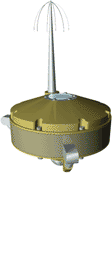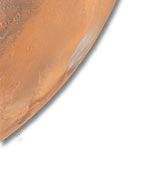 The Deep Space 2 probes are the first completely integrated and miniaturized systems built
by NASA for space flight. Each probe will test technologies to prove they work in the harsh
environment of space. Both probes are tiny data-gathering laboratories. Microinstruments
in the lower spacecraft (forebody) collect a sample of soil and analyze it for water content.
Data from the forebody is sent through a flexible cable to the upper spacecraft (aftbody) at
the surface; a telecommunications system on the aftbody relays data to the Mars Global
Surveyor Spacecraft, operating in orbit on its mapping mission.
The Deep Space 2 probes are the first completely integrated and miniaturized systems built
by NASA for space flight. Each probe will test technologies to prove they work in the harsh
environment of space. Both probes are tiny data-gathering laboratories. Microinstruments
in the lower spacecraft (forebody) collect a sample of soil and analyze it for water content.
Data from the forebody is sent through a flexible cable to the upper spacecraft (aftbody) at
the surface; a telecommunications system on the aftbody relays data to the Mars Global
Surveyor Spacecraft, operating in orbit on its mapping mission.
 The microprobes are also revolutionary in the way they will plunge into Mars. Typical
spacecraft use a parachute and rockets, as well as an aeroshell, to slow their descent
through an atmosphere and land safely. The Deep Space 2 probes are the first spacecraft
to use only an aeroshell. By eliminating parachutes and rockets, the probes are lighter
and less expensive, but also very hardy. Similar in weight to a lap-top computer, they
are designed to survive a high-speed impact, and to operate successfully in extremely
low temperatures, something conventional miniaturized electronics, and
standard spacecraft, could never do.
The microprobes are also revolutionary in the way they will plunge into Mars. Typical
spacecraft use a parachute and rockets, as well as an aeroshell, to slow their descent
through an atmosphere and land safely. The Deep Space 2 probes are the first spacecraft
to use only an aeroshell. By eliminating parachutes and rockets, the probes are lighter
and less expensive, but also very hardy. Similar in weight to a lap-top computer, they
are designed to survive a high-speed impact, and to operate successfully in extremely
low temperatures, something conventional miniaturized electronics, and
standard spacecraft, could never do.
|


